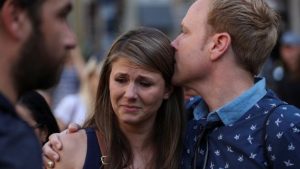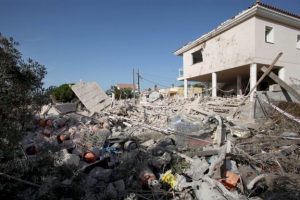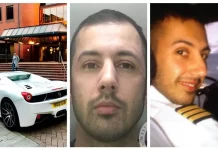There have been two attacks in Spain’s Catalonia area comprising of people driving cars at crowds at high-speeds.
Now is what we known at the moment. What happened?
On the afternoon on Thursday at 16:50 local time (14:50 GMT) a white van crashed into people on Las Ramblas, a famous place in central Barcelona that runs 1.2km (0.75 miles) and was packed with visitors.
The driver of the van is said to have zig-zagged to attempt and hit as many people as possible throughout the pedestrian zone, hitting countless to the ground and casting others escaping for cover in stores and cafes.
He murdered 13 people and wounded more than 100, and succeeded to escape the scene.
Spanish police have labelled it as an attack on terror.
What was the second attack?
Only eight hours afterwards, an Audi A3 car smashed into walkers in the well-liked seaside resort city of Cambrils, 110km (68 miles) south-west of Barcelona.
6 inhabitants were wounded, 1 critically, and a police officer was injured as well.
The attackers’ automobile tipped over and 5 alleged terrorists, many of who seemed to be wearing suicide belts, were then shot by the police. 4 died at the site and 1 afterwards died of his wounds.
Organised detonations were executed and authorities afterwards reported that the explosive belts were false.
The Las Ramblas and Cambrils assaults are supposed to be connected.
Who has been arrested?
On Thursday, 1 person from Spain’s North African enclave of Melilla was under arrest in Alcanar and a Moroccan was arrested in Ripoll. Both of them are cities in Catalonia – the same area as Barcelona.
Official papers belonging to the Moroccan, 28-year-old Driss Oubakir, were supposedly used to lease the van utilised in the Las Ramblas assault in the local media statement he has said his papers were stolen and used without his knowledge.
Driss Oubakir’s younger brother, 18-year-old Moussa Oubakir, is alleged to be the Las Ramblas aggressor and authorities are looking for him, say the Spanish media report.
Then on Friday, police declared that an additional arrest in Ripoll. It remains uncertain how many individuals were entangled in the plans.
Weren’t there other incidents too?
Then on the evening of Thursday at 19:30 local time, a vehicle was smashed into officers at a barrier on the borders of Barcelona.
The automobile was afterwards discovered with a deceased man in the car, but the interior ministry has rejected early accounts he was killed by police gunfire. Officials haven’t ruled out a connection with the Las Ramblas attack but enquiries are in progress.
On Wednesday night, an eruption entirely demolished a home in Alcanar, 200km south of Barcelona, killing 1 individual and injuring 7.
The home was occupied with bottles of propane and butane, Spanish newspaper El Pais has said (in Spanish).
The event is linked to Thursday’s events, police have said.
In addition, on Thursday, shortly afterwards the first attack, an additional van believed to be a getaway automobile was discovered in the town of Vic, 80km north of Barcelona.
Who are the victims?
They originate from all over the globe, with at least 24 races represented.
Individuals from Ireland, France, Australia, China, Pakistan, Venezuela, Algeria, Peru, Germany, the Netherlands, Greece, Hong Kong, Taiwan, Ecuador, the US, Argentina, Romania, Cuba, Austria and the Philippines are all said to be amongst those injured.
Belgium say 1 of its residents was killed and France say 26 of its citizens were hurt, 11 seriously. The Australian government say at least 4 of their inhabitants were hurt.
Who is responsible?
The So-called Islamic State (IS) has reported it was responsible for the Las Ramblas attack and that IS “soldiers” executed it. Although they didn’t give any proof or facts to support their claim.
Why Spain?
The Country is one of Europe most well-liked destination for travellers however recently hasn’t has the type of jihadist aggression that has shocked France, the UK, Belgium and Germany.
But, Spain has been aimed at beforehand – numerous trains in Madrid, the capital, were blasted by al-Qaeda inspired militants in 2004, murdering 191 people.
The IS news outlet, Amaq, say the attack was carried out as part of efforts to target states fighting in the US-led anti-IS coalition.
How much jihadist activity is there in the country?
The amount of actions executed against jihadists has risen considerably when Spain elevated its terror alert level to four out of five in June 2015, implying that there was a “high risk” of a terror attack.
Beforehand these assaults, 51 alleged jihadists had already been imprisoned in the country this year, while 69 were incarcerated last year, and 75 were imprisoned in 2015, according to El Pais.
Safety and surveillance was increased after the truck attacks in the French city of Nice in July 2016 and the German capital Berlin in December.
On Twitter, the Spanish royal household posted: “They are murderers, nothing more than criminals who are not going to terrorise us. All of Spain is Barcelona.”
World leaders have provided help and a message of solidarity.
British Prime Minister Theresa May said she was “sickened by the senseless loss of life in Barcelona”.
US President Donald Trump rapidly criticized the attack on Twitter but has come under scrutiny for raising a debunked myth about a general who battled Islamist militants by applying pig’s blood to perform mass killings.









































